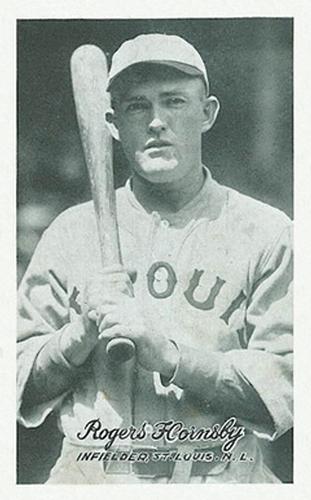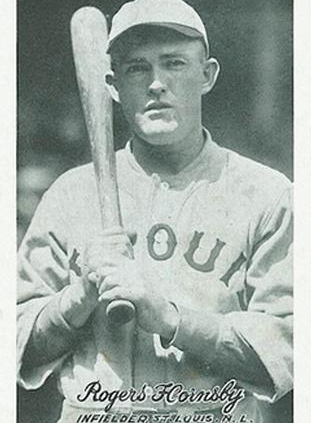June 21, 1921: Rogers Hornsby continues to impress as Cardinals score 17 runs in rout of Cubs
 The St. Louis Cardinals had their most exemplary offensive performance of the 1921 season on June 21. Mother Nature had provided a brief hiatus for the team; this game was initially scheduled for a day earlier, but “[a] terrific rain, hail, and wind storm hit the town just before game time”1 and forced rescheduling of the contest as part of a doubleheader the next day.
The St. Louis Cardinals had their most exemplary offensive performance of the 1921 season on June 21. Mother Nature had provided a brief hiatus for the team; this game was initially scheduled for a day earlier, but “[a] terrific rain, hail, and wind storm hit the town just before game time”1 and forced rescheduling of the contest as part of a doubleheader the next day.
Gameday arrived at Sportsman’s Park with the Chicago Cubs in sixth place, four games behind the fourth-place Cardinals. This was their 10th game of the season against each other, with the Cardinals winning five of the first nine. (Each of the previous four series between the teams had resulted in a sweep, with two each by St. Louis and Chicago.)
In a season where the emergence of power hitting was changing the way teams approached run-scoring, St. Louis used some Deadball Era small-ball to bring home the first run of the contest against Cubs starter Speed Martin. In the bottom of the first, a combination of walks and good baserunning brought Jack Smith to third base with one out. Milt Stock hit a popup to shortstop Charlie Hollocher in short left field, and Smith bluffed home. The St. Louis Post-Dispatch described what happened next: “[A]fter getting a lead of 30 feet, Smith made good on his bluff and ran home, beating the astonished Hollocher’s throw home to catcher Bill Killefer and staking the home team to an early 1-0 lead.”2
The third inning brought some of the more muscular methods of offense back into focus. After the teams went back and forth with home runs from Chicago’s Max Flack and St. Louis’s Smith, a two-run double by Cardinals slugger Jack Fournier put St. Louis back on top, 4-2.
But after RBIs in the Cubs fourth by John Sullivan and Killefer, the Cardinals could not hold the lead and came to the plate in the bottom of the inning with the score again tied, 4-4. St. Louis’s patience at bat, however, soon restored the Cardinals’ advantage. With two outs and the bases loaded on two walks and a single, Chicago’s Buck Freeman, who had replaced Martin in the third inning, walked Stock. The seventh free pass of the game by Cubs pitching brought veteran Burt Shotton in to score and put the home team back on top, 5-4.
Freeman’s walk of Stock meant the most feared slugger in the National League was coming to the plate. Already an accomplished hitter at age 25 who had led the NL in such prominent offensive categories as batting average, RBIs, and hits, Rogers Hornsby was the last hitter the Cubs wanted to face in a bases-loaded situation. Just three months into what would be a remarkable five-year stretch, Hornsby began the day batting .409/.465/.655.
He managed to get only one hit in the ballgame, but he made it count. Batting with the bases loaded and two outs, Hornsby broke the contest open with an opposite-field shot into the right-field bleachers for a grand slam and a 9-4 Cardinals lead.
The fifth inning brought a new hurler to the mound for St. Louis, with starting pitcher Bill Pertica departing in favor of Marv Goodwin after tossing just four pedestrian innings of four-run ball. After the Cubs got a run back in the fifth when Ray Grimes’ RBI groundout scored Flack, the Cardinals responded with three more runs in the bottom of the inning for a 12-5 advantage. Doc Lavan and Cliff Heathcote drove in runs with RBI doubles, and Jack Smith’s sacrifice fly scored another run.
Though Hornsby dealt the critical blow, Smith, the Cardinals’ leadoff hitter and right fielder, spent the entire afternoon wearing out Chicago’s pitching staff with his all-around excellence. Besides his sacrifice fly in the fifth, Smith scored a run in the first inning on alert baserunning after a leadoff walk, homered in the second, singled and scored in the fourth, and had another RBI single in the sixth. In his final plate appearance, in the eighth inning, he received his second free pass of the contest.
St. Louis tacked on another five runs in the bottom of the sixth off Freeman, by then on his fourth inning of relief work. In between run-scoring base hits by Verne Clemons, Smith, and Stock, Freeman issued yet another walk and threw a wild pitch that allowed a run to cross the plate. Only a heads-up play by Cubs backstop Killefer prevented the inning from getting more out of hand, as he threw out Stock trying to take second base on his RBI single.
The Cardinals did not put any more runs on the board after the sixth inning. Part of the retreat was perhaps by design, as St. Louis manager Branch Rickey made wholesale changes to his lineup over the final two innings. Charlie Niebergall, Reuben Ewing, Les Mann, and even pitcher Bill Sherdel entered the game as defensive replacements.3 With so many “bargain-day bills” on the coming schedule, Rickey knew rest for his players would be necessary.4 The Cardinals closed out the 17-5 win.
Goodwin pitched the final five innings of the game for St. Louis, allowing only one run, but Pertica was still awarded the victory for his four innings of work. In 1916 National League Secretary John Heydler had issued a memo stating, “Do not give the first pitcher credit for a game won even if score is in his favor, unless he has pitched at least the first half of a game. A pitcher retired at close of fourth inning, with the score 2-1 in his favor, has not won a game. If, however, he is taken out because of his team having secured a commanding and winning lead in a few innings, then he is entitled to the win.” Nevertheless, the official scorer at Sportsman’s Park did not follow Heydler’s guidance. This antiquated type of win, dubbed an “archaic win,” was still being awarded in the National League by official scorers about 40 percent of the time in 1921, with that number shrinking to as low as 20 percent just a few seasons after. American League President Ban Johnson was much slower to transition to widespread acceptance of the modern interpretation of a “pitcher win,” and it wasn’t until 1950 that the five-inning rule became the standard for both leagues.5
The Cardinals, who would lose the second game of the doubleheader, 6-3, scored their highest run total of the season in the first game, and accomplished it all in 2 hours and 10 minutes. The entire offense contributed to the outcome; every starting position player reached base at least once.
Hornsby’s blast was his only grand slam of the season. He finished the season with a batting line of .397/.458/.639, which was actually slightly below his totals for the next five seasons. From 1921 through 1925, Hornsby compiled an astronomical triple slash of .402/.474/.690, resulting in an OPS+ of 204. In other words, he was more than twice as productive as a league-average hitter over that time. Perhaps to no one’s surprise, he too led the league in on-base percentage, slugging, and OPS over that five-year stretch.6
Though the Cardinals had a record of 58-39 from this game through the rest of the season, even a .598 winning percentage wasn’t good enough to get them into the World Series: They finished in third place, seven games behind the eventual World Series champion New York Giants.
Sources
In addition to the sources cited in the Notes, the author consulted Baseball-Reference.com and Retrosheet.org.
https://www.baseball-reference.com/boxes/SLN/SLN192106211.shtml
https://www.retrosheet.org/boxesetc/1921/B06211SLN1921.htm
Notes
1 I.E. Sanborn, “Rain Halts Cubs,” Chicago Tribune, June 21, 1921: 19.
2 “Hornsby Pounds Out Homer with 3 on in Fourth,” St. Louis Post-Dispatch, June 21, 1921: 18.
3 Martin J. Haley, “Slugging by St. Louis Is Feature of Opening Conflict of Afternoon,” St. Louis Globe-Democrat, June 22, 1921: 8. Sherdel entered the game as a first baseman.
4 Martin J. Haley, “Four Double-Headers on Card Against Cubs and Pirates in That Time,” St. Louis Globe-Democrat, June 21, 1921: 6.
5 Frank Vaccaro, “Origin of the Modern Pitching Win,” SABR Baseball Research Journal, 2013.
6 C. Paul Rogers III, SABR BioProject, Rogers Hornsby, accessed March 27, 2021.
Additional Stats
St. Louis Cardinals 17
Chicago Cubs 5
Game 1, DH
Sportsman’s Park
St. Louis, MO
Box Score + PBP:
Corrections? Additions?
If you can help us improve this game story, contact us.


